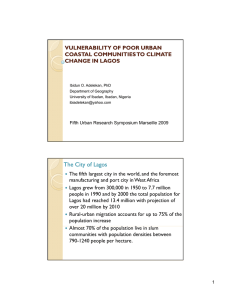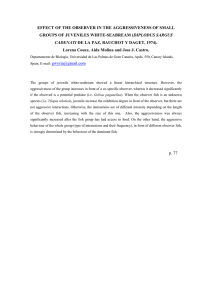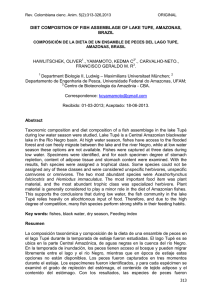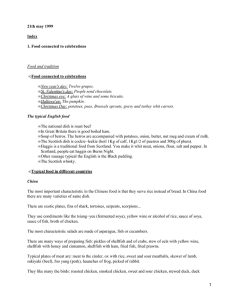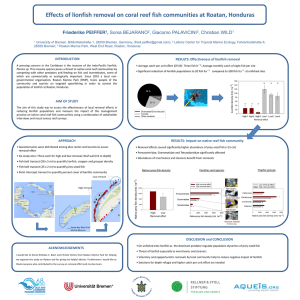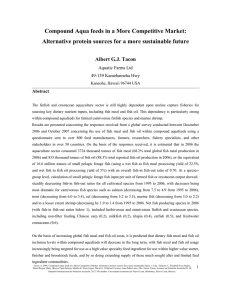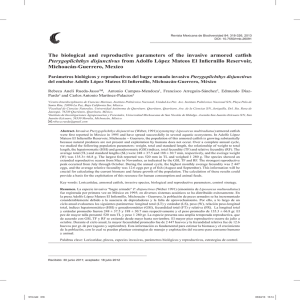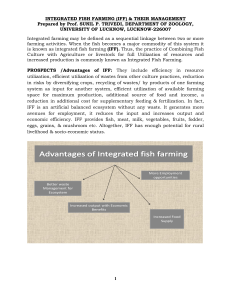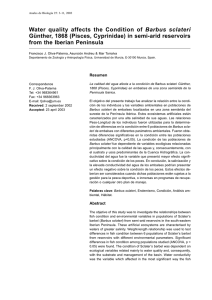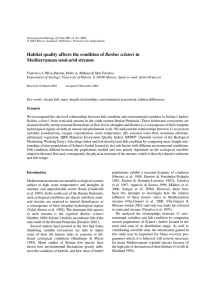length-weight relationship of eleven fish species of the
Anuncio
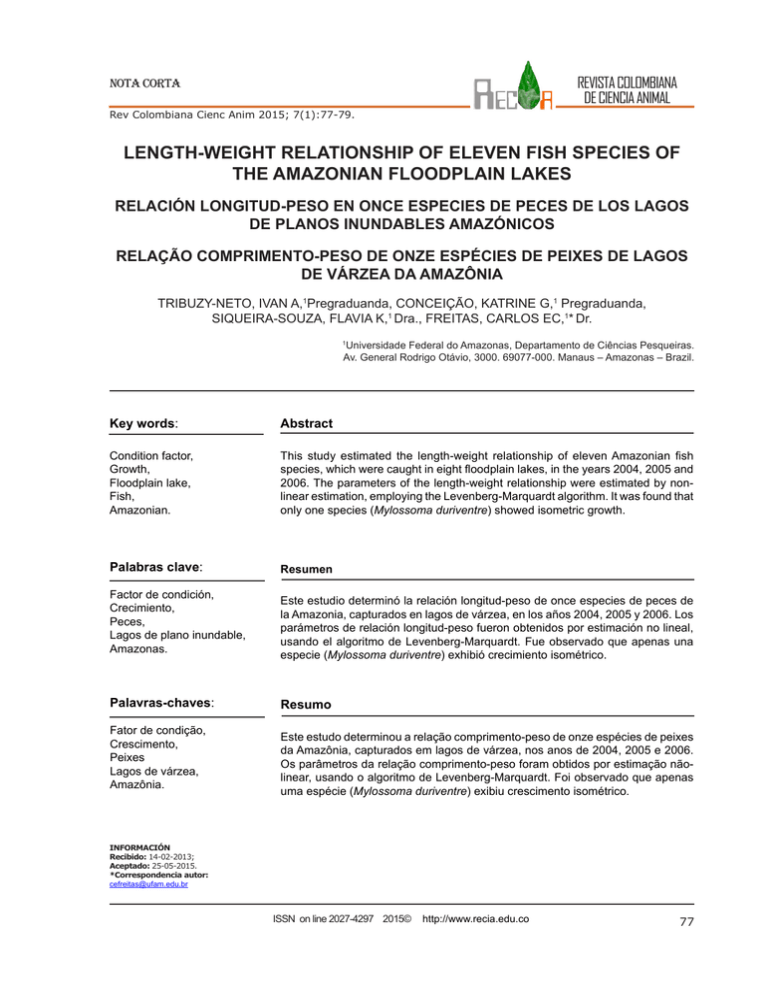
REVISTA COLOMBIANA DE CIENCIA ANIMAL NOTA CORTA Rev Colombiana Cienc Anim 2015; 7(1):77-79. LENGTH-WEIGHT RELATIONSHIP OF ELEVEN FISH SPECIES OF THE AMAZONIAN FLOODPLAIN LAKES RELACIÓN LONGITUD-PESO EN ONCE ESPECIES DE PECES DE LOS LAGOS DE PLANOS INUNDABLES AMAZÓNICOS RELAÇÃO COMPRIMENTO-PESO DE ONZE ESPÉCIES DE PEIXES DE LAGOS DE VÁRZEA DA AMAZÔNIA TRIBUZY-NETO, IVAN A,1Pregraduanda, CONCEIÇÃO, KATRINE G,1 Pregraduanda, SIQUEIRA-SOUZA, FLAVIA K,1 Dra., FREITAS, CARLOS EC,1* Dr. Universidade Federal do Amazonas, Departamento de Ciências Pesqueiras. Av. General Rodrigo Otávio, 3000. 69077-000. Manaus – Amazonas – Brazil. 1 Key words: Abstract Condition factor, Growth, Floodplain lake, Fish, Amazonian. This study estimated the length-weight relationship of eleven Amazonian fish species, which were caught in eight floodplain lakes, in the years 2004, 2005 and 2006. The parameters of the length-weight relationship were estimated by nonlinear estimation, employing the Levenberg-Marquardt algorithm. It was found that only one species (Mylossoma duriventre) showed isometric growth. Palabras clave: Resumen Factor de condición, Crecimiento, Peces, Lagos de plano inundable, Amazonas. Palavras-chaves: Fator de condição, Crescimento, Peixes Lagos de várzea, Amazônia. Este estudio determinó la relación longitud-peso de once especies de peces de la Amazonia, capturados en lagos de várzea, en los años 2004, 2005 y 2006. Los parámetros de relación longitud-peso fueron obtenidos por estimación no lineal, usando el algoritmo de Levenberg-Marquardt. Fue observado que apenas una especie (Mylossoma duriventre) exhibió crecimiento isométrico. Resumo Este estudo determinou a relação comprimento-peso de onze espécies de peixes da Amazônia, capturados em lagos de várzea, nos anos de 2004, 2005 e 2006. Os parâmetros da relação comprimento-peso foram obtidos por estimação nãolinear, usando o algoritmo de Levenberg-Marquardt. Foi observado que apenas uma espécie (Mylossoma duriventre) exibiu crescimento isométrico. INFORMACIÓN Recibido: 14-02-2013; Aceptado: 25-05-2015. *Correspondencia autor: cefreitas@ufam.edu.br ISSN on line 2027-4297 2015© http://www.recia.edu.co 77 REVISTA COLOMBIANA DE CIENCIA ANIMAL Introduction The Amazon basin is home to one of the most diverse freshwater fish fauna of the world (REIS et al., 2003). Strongly influenced by the flood pulse, which promotes dramatic and cyclical changes in the environment, the floodplains are the most productive areas in this basin (JUNK et al., 1989) and are important habitats for several species of commercial importance for the Amazonian fisheries (PETRERE JR, 1989; BATISTA e PETRERE JR, 2007). Besides their importance, there are substantial gaps of biological information for some of these species. Aiming to contribute to fill this gaps and to build a base for fishing management, the objective of this study was to estimate the length-weight relationship and identify growth patterns, isometric or allometric, for 11 fish species of the Amazonian floodplain lakes. Material and methods Tribuzy-Neto, et al. Table 1. Number of individuals belonging to the eleven studied families, indicating the maximum and minimum length (Lmax and Lmin, respectively). Family Species N Lmax Lmin Loricariidae Pterygoplichthys pardalis 888 9 53 Prochilodontidae Prochilodus nigricans 334 7.5 43 Curimatidae Potamorhina altamazonica 928 9.5 24 Curimaridae Potamorhina latior 562 8 21.5 Curimatidae Psectrogaster rutiloides 717 3.5 18 Serrasalmidae Colossoma macropomum 255 10 36 Serrasalmidae Mylossoma duriventre 254 5,5 22 Serrasalmidae Serrasalmus spilopleura 557 5 20 Serrasalmidae Serrasalmus elongatus 252 6 28 Serrasalmidae Pygocentrus nattereri 3420 5 28 Osteoglossidae Osteoglossum bicirrhosum 176 10.4 70.5 Table 2.Parameters of the length-weight relationships estimated for 11 Amazonian floodplain fish species, indicating their confidence interval and the R2. Species Pterygoplichthys pardalis The samples were collected between the years of 2004 and 2006 in eight floodplain lakes along the middle and lower stretches of the Solimões River. Fish were collected with eight monofilament gillnets of different mesh sizes: 30, 40, 50, 60, 70, 80, 90 and 100mm between opposite knots. Nets were size standardized in 20 m long x 2 m deep. In general, collected fish were identified, measured (standard length, cm) and weighed (total body mass, g) immediately after catch. Fish that the identification was dubious were taken to the Laboratory of Fishing Ecology at the Federal University of Amazonas (UFAM) aiming to confirm its identification. The parameters of the weight-length relationship were determined by non-linear estimation, employing the Levenberg-Marquardt algorithm (MYERS, 1990). All statistical procedures were performed using the software Statistica 9.0 (STATSOFT, 2009). Results Were weighed and measured a total of 8,343 individuals of eleven species, belonging to five families (Table 1). The Table 2 shows the values of a and b, their confidence intervals and the r², obtained through the weight-length relationship. Only one specie (Mylossoma duriventre) presented isometric growth (b=3). The remaining species showed values that demonstrates negative alometric growth. A Lower Upper limit a limit a b Lower Upper limit b limit b R2 0.8668 0.6611 1.0726 1.8165 1.7435 1.8895 0.898 Prochilodus nigricans 0.2115 0.1458 0.2773 2.3510 2.2555 2.4466 0.944 Potamorhina altamazonica 0.0312 0.0241 0.0383 2.8984 2.8211 2.9757 0.940 Potamorhina latior 0.0248 0.0186 0.0309 2.8888 2.8010 2.9766 0.952 Psectrogaster rutiloides 0.0729 0.0562 0.0898 2.6037 2.5162 2.6912 0.923 Colossoma macropomum 0.0716 0.0525 0.0908 2.7710 2.6873 2.8547 0.921 Mylossoma duriventre 0.0429 0.0311 0.0549 3.0040 2.9046 3.1034 0.960 Serrasalmus spilopleura 0.0698 0.0534 0.0861 2.8018 2.6982 2.8751 0.930 Serrasalmus elongates 0.0533 0.0285 0.0781 2.7191 2.5259 2.8572 0.870 Pygocentrus nattereri 0.1100 0.0995 0.1206 2.6800 2.6470 2.7130 0.952 Osteoglossum bicirrhosum 0.0381 0.0126 0.0637 2.5600 2.3923 2.7313 0.937 Discussion Among the 11 species analyzed, we found that only Mylossoma duriventre showed isometric growth. In other words, its weight increases proportionately with the length. The allometric coefficient estimated for the others species showed that they follow a negative allometric growth. The estimated values of the parameter ‘a’, condition factor, were higher than estimates obtained by ISAAC E RUFFINO (1995) for O. bicirhossum, P. nigricans, M. duriventre, P. nattereri e L. pardalis (now Pterygoplichthys pardalis) caught at the lower Amazon stretch. An opposite pattern was observed for C. macropomum. By the other hand, the estimates of the condition factor were higher than values obtained by CATARINO et al. (2014) for P. nigricans caught in a floodplain lake of the lower stretch of the Solimões River. 78 REVISTA COLOMBIANA DE CIENCIA ANIMAL Tribuzy-Neto, et al. References BATISTA, V.S.; PETRERE JR., M. 2007. Spatial and temporal distribution of fishing resources exploited by the Manaus fishing fleet, Amazonas, Brazil. Brazilian Journal of Biology 67:53-66. CATARINO, M.F.; CAMPOS, C.P.; GARCEZ, R.; FREITAS, C.E.C. 2014. Population dynamics of Prochilodus nigricans caught in Manacapuru Lake (Amazon Basin, Brazil). Boletim do Instituto de Pesca 40:589-595. JUNK, W.J.; BAILEY, P.B.; SPARKS, R.E. 1989. The floodpulse concept in river-floodplain systems. em: Dodge, D. (edit.), Proceedings of the International Large River Symposium. Canadian Special Publication of Fisheries and Aquatic Sciences 106:110-127. MYERS, J.H. 1990. Population cycles of western tent caterpillars: experimental introductions and synchrony of fluctuations. Ecology 71:986-995. PETRERE JR, M. 1989. River fisheries in Brazil: a review. Regulated Rivers 4:1-16. REIS, R.E.; KULLANDER, S.O.; FERRARIS, C.J. Jr. 2003. Check list of the freshwater fishes of South and Central America. Edipucrs. Porto Alegre, Brasil. RUFFINO, M.L.; ISAAC, V.J. 1995. Life cycle and biological parameters of several Brazilian Amazon fish species. NAGA The Iclarm quarterly 4:41-45. STATSOFT Inc. (2009) STATISTICA (data analysis software system). Version 9.0. www.statsoft.com. 79
